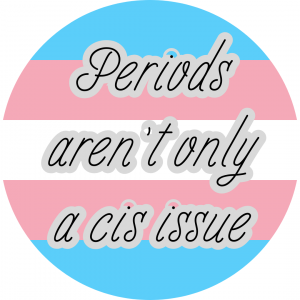By: Mikayla Hunter (she/they)
It is not only cisgender women who menstruate. For some, this idea may be something they are already aware of and understand to be true. For others, it may be a little more difficult. To understand that menstruation is not an experience specific to women, we must first understand what we mean by gender.

The term cisgender refers to a person whose gender identity aligns with the sex they were assigned at birth.1 Transgender is a term for people whose gender identity does not align with the sex they were assigned at birth.1 It is important to note that both ‘cis’ and ‘trans’ are simply prefixes that add additional information to a word or an idea, and neither of these terms are slurs. For example, we can refer to a book as a hardcover book to give more information about the book that we are talking about. Cis is a prefix that means ‘on the same side as’ and trans means ‘on the other side of’. This means that a cisgender woman is a woman whose gender identity is ‘on the same side as’ the sex she was assigned at birth. A transgender man is a man whose gender identity is ‘on the other side of’ the sex he was assigned at birth. With these ideas in mind, we can understand that both cisgender women and transgender men may have a uterus and experience menstruation. However, it is not just cisgender women and transgender men who may have these experiences.
Gender diverse people have a wide range of gender identities and/or gender expressions that do not conform to socially defined gender norms of men and women.2 There are many terms and identities that people may use to describe themselves including non-binary, agender, genderqueer, and gender non-conforming to name a few. Gender diversity does not look a specific way, and the experiences of gender diverse people can (and do) vary. For example, not every gender diverse person will dress androgynously and not all of them will experience menstruation. However, some of them will. Similar to how both cisgender women and transgender men can experience menstruation, so can gender diverse people. A person who menstruates doesn’t look any one specific way or identify as a woman.
Importantly, menstruation can cause gender dysphoria for transgender and gender diverse people. Gender dysphoria is the experience of discomfort or distress because there is a mismatch between a person’s sex assigned at birth and their gender identity.3 For some transgender and gender diverse people, they may undergo procedures such as hysterectomy to relieve gender dysphoria and as a part of their gender journey. However, not everyone has access to these surgical procedures for a variety of reasons and so, menstruation can be all the more difficult for transgender and gender diverse people.

Femininity and menstruation do not go hand-in-hand. A person’s gender identity is their internal sense of gender, or lack thereof. The biological function of our bodies is not directly tied to our gender identities. And so, saying that only women menstruate is incorrect. As Kimberlé Crenshaw explains,4 when policies that support women only support women and policies that support Black, Indigenous, and People of Colour (BIPOC) people only support BIPOC men, BIPOC women are not supported by either policy. When we consider the idea of menstrual equity, we need to ensure that all bodies that menstruate are included and not just cisgender women. Otherwise, we haven’t achieved menstrual equity at all if people are being left out of advocacy and policy changes.
References
[1] Rainbow Center. (2018). Rainbow Center’s LGBTQIA+ dictionary. The University of Connecticut.
[2] https://www.dictionary.com/browse/gender-diverse
[3] https://www.stonewall.org.uk/list-lgbtq-terms
[4] https://www.youtube.com/watch?v=ViDtnfQ9FHc
May 28th is menstrual hygiene day, and this year, the theme is “Together for a #PeriodFriendlyWorld.” While this observance was originally framed as menstrual hygiene – we follow the lead of the World Health Organization, who calls for menstrual health to be recognized, framed, and addressed as a human rights issue, not a hygiene issue. Framing menstruation as such is a reflection of the taboo and stigma around periods. The labelling of period supplies as “feminine hygiene products” is incorrect since as Dr. Jen Gunther explains “needing them is not a sign of being feminine – it’s a sign that you need something to catch blood – and they’re not hygiene products because menstruating is not unhygienic.”
In 2023-2024, the Centre for Human Rights Research at the University of Manitoba has worked on the “Period Poverty & Equity, On Campus and Beyond” project to assess access to period supplies for the University of Manitoba community and to work towards menstrual equity, on campus and in the community. This series of essays is part of the Period Poverty & Equity, On Campus and Beyond project and aims to explore issues of menstrual justice that are often overlooked.

